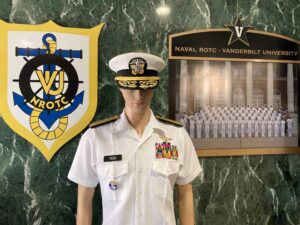The Reserve Officers’ Training Corps (ROTC) is a program to educate and train future US military officers at civilian colleges and universities. Students are both full-time college students and ROTC cadets or midshipmen. They take courses in military, air, or naval science in addition to their other college classes. They do regular military training during the school year and over the summer to prepare them for their role as future military officers. ROTC scholarships pay for up to 100% of tuition and can be used at many colleges around the US.
What Are the Different ROTC Programs?
There are three different ROTC programs. Army ROTC trains future Army, Army Reserve, and Army National Guard officers. Navy ROTC trains future Navy and Marine Corps officers, and has a special track for Navy Nursing. Air Force ROTC trains future Air Force officers and now some cadets the option of commissioning into the Space Force.

ROTC Host Units and Cross Town Agreements
Students can only participate in ROTC at colleges that host a ROTC unit for that program, or that are a cross town affiliate with a unit at another college. For example, the Massachusetts Institute of Technology Navy ROTC unit includes cross town students from Harvard and Tufts. Meanwhile, Air Force ROTC Det 60 at University of Southern California includes students from USC as well as students from two dozen nearby colleges including Embry-Riddle, Occidental, Cal State Polytechnic Pomona, and Chapman.
Make sure that there is a ROTC unit or cross town agreement for the specific program you want to join. Students at Occidental for example could affiliate with the Army ROTC unit at UCLA or the Air Force ROTC unit at USC, but do not have a Navy ROTC option.
How to Locate Colleges with ROTC Programs
Use these search tools to find colleges that host or have cross town agreements with ROTC units.
Army ROTC Schools Search
Navy ROTC Schools List
Air Force ROTC College Locator
ROTC Scholarships for High School Students
High school students should plan to start their ROTC scholarship applications in April-July before senior year. ROTC scholarship review boards are held over the fall and winter.
Students should plan to submit the strongest application they can as soon as they can. It isn’t necessary to complete the application as soon as it opens. Make sure you carefully review your application and thoughtfully write your personal statements. Ensure you are well prepared for the fitness tests. At the same time, don’t procrastinate to the last minute. And be sure you understand your deadlines to complete the online application and submit any additional paperwork.
ROTC scholarship applications typically require an academic record, SAT/ACT test scores, teacher recommendations, activities list, essay responses, an interview, and a fitness assessment. Students are evaluated on their academic ability and potential as future military leaders. Students selected for a ROTC scholarship must also go through a medical review board that determines if they are medically qualified to serve in the military.
Remember that ROTC scholarships are completely separate from your college applications. It’s common to not get final results on the scholarship until spring of senior year. So it’s also essential to apply to colleges where you’d like to participate in ROTC. You’ll probably have to complete these college applications around the same time you do the scholarship applications.
Related Article: Air Force ROTC Scholarships

ROTC Scholarships for College Students
College students can join a ROTC unit whether or not they have been awarded a 4-year scholarship. They would take the same ROTC courses and do the same school year training events, but usually don’t do summer training. Non-scholarship students may be considered for 3- or 2-year scholarships or a contract that results in a commission after graduation. Success in earning a scholarship as a college student depends on college grades and performance as a ROTC cadet or midshipman.
ROTC Scholarship Benefits
ROTC scholarships pay for part or all of college tuition and required fees, depending on the program and scholarship category. Scholarships usually also include a book allowance, uniforms, and a monthly tax-free stipend. (Some ROTC programs allow students to choose to receive a Room and Board allowance instead of the tuition scholarship.)
Some colleges offer additional benefits to students on ROTC scholarships. These might include reducing tuition to in-state rates or a scholarship to help pay for food and housing.
Basic Eligibility for ROTC Scholarships
Be a US citizen
Be within age requirements
Have a high school diploma or equivalent
Meet fitness standards
Meet physical (medical) standards
Agree to accept a commission and serve in the respective branch of the military after graduation
How to Apply for ROTC Scholarships
The specific eligibility, application, and military service requirements vary according to which ROTC program the student joins and what career path they are assigned after graduation. See each Reserve Officers’ Training Corps program page for current information.
Navy ROTC scholarship for Navy, Navy Nursing, and Marine Corps
Air Force ROTC scholarship for Air Force and Space Force
Army ROTC scholarship for Army, Army Reserve, and Army National Guard
Learn More About How ROTC Scholarships Help Pay for College

I was a guest on the College and Career Clarity podcast, where the host and I talked about ROTC scholarships, and how college ROTC programs differ from both high school Junior ROTC and military service academies. Listen to the ROTC Scholarship episode.
Share